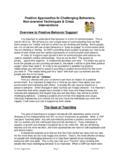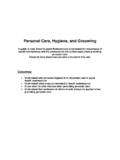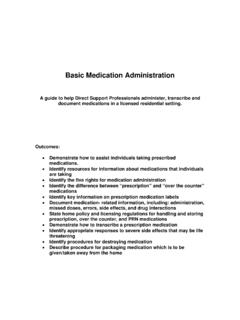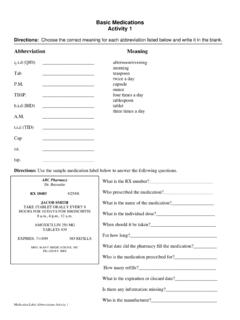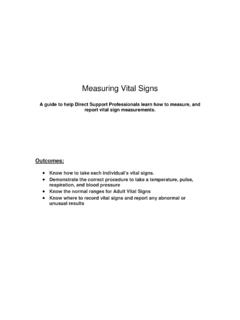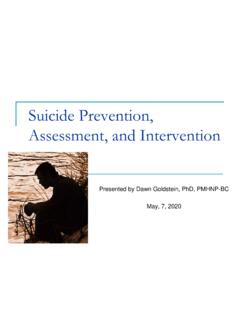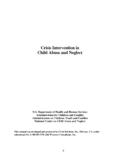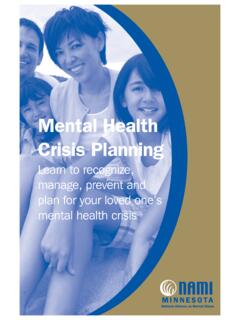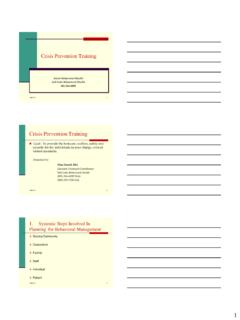Transcription of Crisis Intervention - CMHCM
1 Crisis Intervention A guide to assist Direct Support Professionals when responding to an emergency situation that places the individual or others at risk of physical harm Outcomes: Direct Support Professional will understand what emergency physical Intervention is and when it can be used. Direct Support Professional will understand the principle of least restrictive to most restrictive. Direct Support Professional will understand what must be documented when emergency physical Intervention is used. Direct Support Professional will understand when it is inappropriate to use emergency physical Intervention .
2 Crisis Intervention TRAINING CHECKLIST **Trainer must have received training in the emergency physical Intervention techniques and demonstrated ability to perform the techniques prior to teaching DSP staff.** 1. Have the Direct Support Professional (DSP) read the unit. 2. Demonstrate the techniques and have the DSP practice each technique . 3. Trainer will complete the Emergency Physical Intervention Skill Demonstrations form. 4. Trainer will review the AFC administrative rules [ ] - Crisis Intervention with the DSP and answer any questions.
3 The trainer should assure the DSP knows where the AFC licensing rules are located in the home for easy reference. Crisis Intervention Crisis Intervention procedures may be used only when an individual has not shown this behavior in the past which is now creating the Crisis situation or there has not been enough time to develop a specialized Intervention plan to reduce the behavior causing the Crisis . This would be considered an emergency situation. The previous unit: Positive Approaches to Challenging Behaviors Non Aversive Techniques should always be reinforced and be considered the primary focus on learning to work with individuals who display challenging behaviors.
4 The more the Direct Support Professional understands the concepts taught in Unit 10 the less chance that Crisis Intervention will happen at all. If the individual requires repeated or prolonged use of Crisis Intervention procedures the licensee needs to contact the individuals designated representative as stated in their person centered plan along with the responsible agency. If there is not a responsible agency in place such as a Community Mental Health Board, a licensed professional who is certified and knowledgeable should assist the licensee with making appropriate recommendations which would involve a review process to evaluate positive alternatives or the need for a specialized Intervention plan.
5 Crisis Intervention may be used for the following reasons: To provide for self-defense or the defense of others To prevent an individual from causing self harm To stop a disturbance that threatens physical injury to any person To obtain possession of a weapon or any dangerous object that is in possession of the individual causing the Crisis To prevent serious property destruction Crisis Intervention will only be used with as little control as necessary and only for as little amount of time needed to help the person regain their self-control.
6 The Crisis Intervention should only be used after other less restrictive methods have been tried and failed. Crisis Intervention techniques should be used with minimum discomfort to the person both physically and mentally. This should allow for the greatest possible comfort and avoid physical injury and mental distress. Crisis Intervention should never be used as a regular routine! Any time a Crisis Intervention method/ technique is used it must be documented in the individual s record and on an incident report. The documentation should include the following: The type of Crisis Intervention that was used (with as many details on the actual incident as descriptive!)
7 How long (amount of time) the Intervention took to implement from beginning to end Page 1 The reasons why the Intervention was used. Have good justification for your decision to use the Crisis Intervention . Be specific and list all the less restrictive alternatives that were tried, how long they were tried, how many times, and what kind of results were received by trying to use them. Always include all names of the direct support professionals who were involved in the Crisis incident and the actions they took. Include the name of the person who authorized the use of the Crisis Intervention .
8 Be sure to include the times and date that the Crisis Intervention was used and the name of the DSP who implemented the Crisis Intervention . A licensee shall make available reports of all uses of Crisis Intervention when requested by the individual or their designated representative, the responsible agency or the Department of Community Health. There should be reporting guidelines in place from your designated agency (Community Mental Health for Central Michigan) that you are required to follow when these types of incidents occur. A licensee or Direct Support Professional are not allowed to use the specific Crisis Intervention techniques described in this unit without proper training.
9 Training must be approved by the responsible agency which will receive approval from the Department of Community Health. The Crisis Intervention techniques described in this unit are the techniques approved and trained by Community Mental Health for Central Michigan. The Techniques to Protect Yourself and Others and Techniques Used to Assist With Regaining Self Control are only to be taught by certified trainers who have approval to teach these techniques from Community Mental Health for Central Michigan. There should be documentation in place to verify the Trainer is certified by Community Mental Health for Central Michigan.
10 Things to know about Crisis Intervention & emergency physical Intervention techniques The Four A s: Decision Steps for Intervening are outlined below if an individual is becoming agitated the DSP should think and plan for the Intervention using these steps. Awareness Physical environment Your emotional state Other people and staff present Outside resources available Assess/Analyze What does the situation mean? Does the person need something? Page 2 What should happen? Do I need to do anything? Anticipate What is the person likely to do next?
